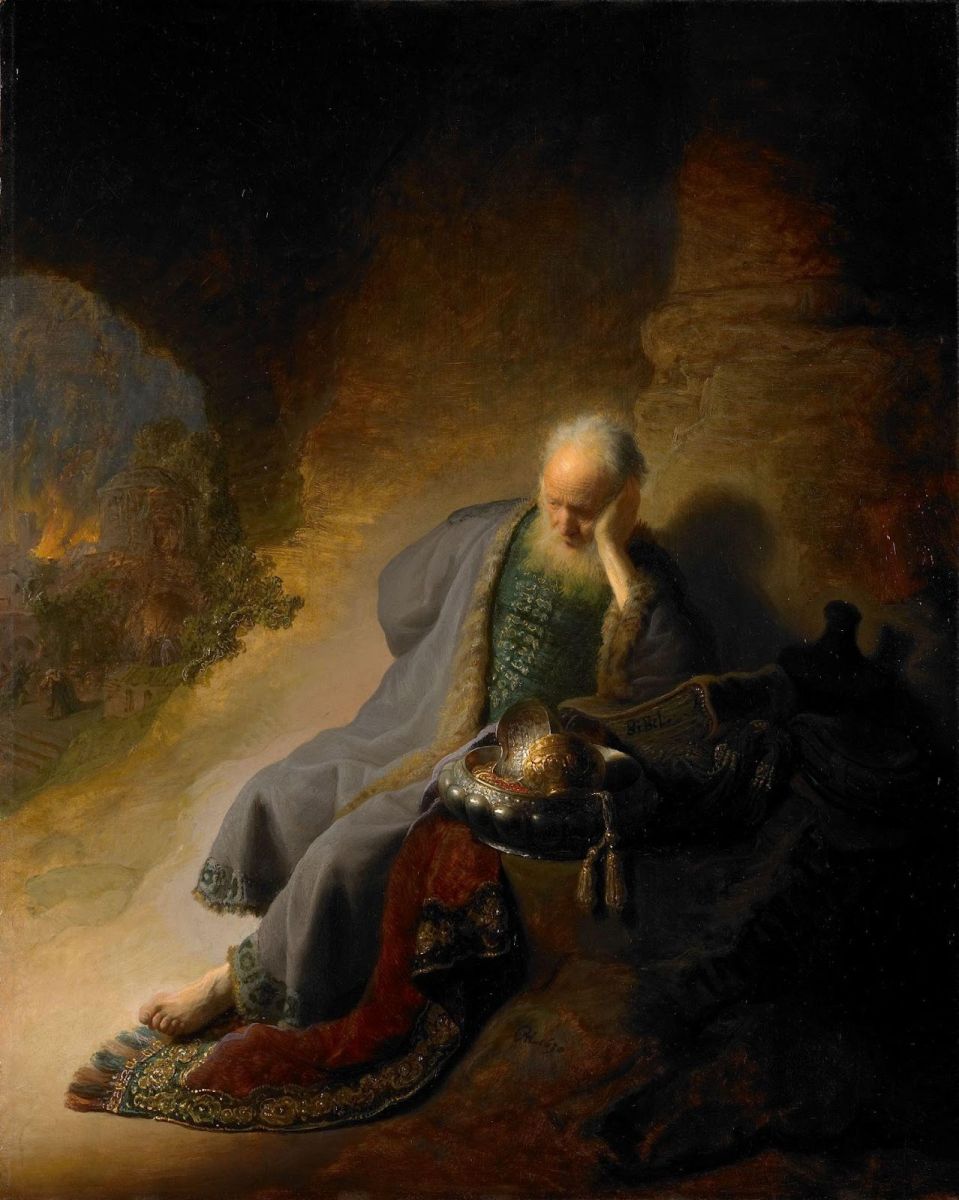Rembrandt - VM - Willem de Vink
Rembrandt: Jeremiah Laments the Destruction of Jerusalem

Who is Lamenting the City?
by Willem de Vink
Even when young, this image of a man allowing the misery of the world around him to enter his consciousness spoke to me: Jeremiah, lamenting over Jerusalem. I must have been about sixteen years old when I bought a reproduction of this painting by Rembrandt. I tried to look at the world in the same way when wandering through the city. Rembrandt painted it in the year before he moved from Leiden to Amsterdam, only twenty years old.
When looking at the painting, you experience the grief of the prophet. His eyes are cast down, his left hand supports his head, because sorrow weighs him down. Rembrandt positioned Jeremiah's weary figure diagonally in the picture, which brings a certain tension into the composition. In the distance below we see the golden city ablaze with fire; the whole painting is shimmering with the glow of the fire.
Israel is invaded by Babylonians and has to submit to their superior strength. We can read about this history in four books of the Bible. First of all, of course, in Jeremiah, in 2 Kings, 2 Chronicles and in Lamentations, the book that begins with “Alas!” and is completely devoted to the fall of the temple city. Jerusalem, the place where God would dwell eternally, has been destroyed. King Zedekiah had his eyes put out (in the painting we faintly see him walking around to the left in the distance with his hands in front of his eyes). The citizens are carried off to Babylon, where they must survive as exiles.
The image of Jeremiah wailing over the city is more than a snapshot. It conveys a vision of the city that recurs time and again in the Bible. It begins with Cain. He built a city in rebellion against God, even though He had promised to protect him. But Cain rather protected himself. People build cities in order not to be dependent on their Creator. In doing so, they make themselves dependent on each other and the powerful can do as they like. That is why the Bible usually paints the city as a problematic place.
Not only Jeremiah, but Jesus also wept over Jerusalem. Even though the city was rebuilt after Jeremiah, its citizens continued to close themselves off from God. That is why Jesus, just like Jeremiah, lamented over her as over a beloved. Through his tears he said: ‘If you, even you, had only known on this day what would bring you peace—but now it is hidden from your eyes’ (Luke 19:42).
The Bible tells us that city dramas will continue until the moment that people will no longer build cities to hide from God, because God himself chooses to come and live with his people in a city. That is indeed a surprising turn in the history of cities! The New Jerusalem will come down from heaven to earth, as we read in the book of Revelation. It is as if God wants to say, ‘If you are so keen to have a city, then I will join in. But then it will be a city like I want it, the New Jerusalem.’ There we will recognise our superior in the Architect and Mayor of the city, who willingly provides us a place where we belong. ‘I will have compassion on your dwellings,’ God promises through Jeremiah.
Also today it is important that there are humble people living in our cities, who have already bent their knee before God. Who are not attached to the city but live there as strangers, because they look forward to another city, representing something different, something new that will come. They pray for their city. They absorb what lives around them and give it back to God filtered by their tears. Just like Jesus and Jeremiah.
*******
For further reading: 2 Chronicles 36:11-21; Genesis 4:10-17; Luke 19:41-44; 21:20; 23:28-31; Revelation 21:1-5; 21:23-26; Jeremiah 30:18; 29:7; 29:11-14; Hebrews 11:10.
Rembrandt van Rijn: Jeremiah Laments the Destruction of Jerusalem, 1630, oil on panel, 58 cm × 46 cm. Rijksmuseum Amsterdam.
Rembrandt van Rijn (Leiden, 1606 – Amsterdam, 1669) was a Dutch painter, etcher, and artist. He is generally counted as one of the greatest painters and etchers in European art and the most important Dutch master of the seventeenth century. In total, Rembrandt produced approximately three hundred paintings, three hundred etchings and two thousand drawings, the best-known being The Night Watch (1642). His work belongs to the baroque style and is influenced by Caravaggism, although he never visited Italy. His remarkable control over light and darkness, whereby he often used sharp contrasts (chiaroscuro), led to lively scenes full of drama. Rembrandt’s repertoire consisted of, among others, biblical scenes, historical pieces, and portraits, including a notable number of self-portraits.
Willem de Vink (Utrecht, b. 1957) is a Dutch speaker, writer, and illustrator. His picture story book Jezus Messias [Jesus Messiah] has been published in more than 200 languages. He also wrote the book Dit is liefde, Vincent [This is Love, Vincent]. He recently published the book In het hoofd van de maker, Creativiteit, Kunst, Kerk [In the Mind of the Maker: Creativity, Art, Church].
ArtWay Visual Meditation 5 February, 2023


